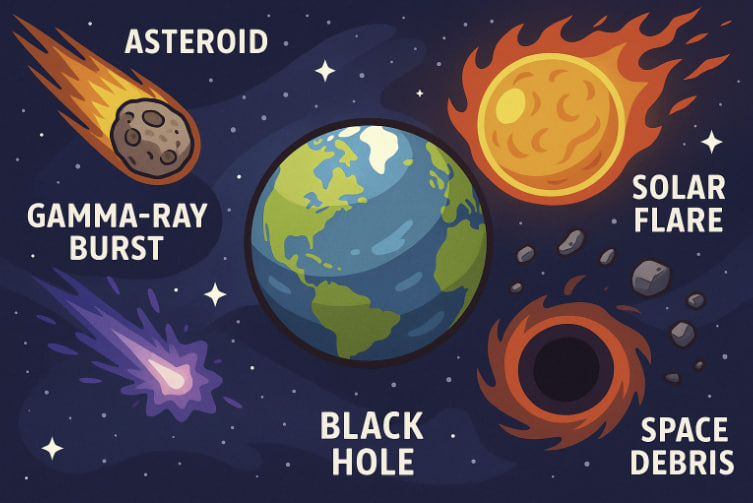Earth may feel like a safe haven, but it exists in a dynamic and sometimes dangerous cosmic environment. From high-speed asteroids to powerful solar storms, space holds a range of potential threats to our planet. Although large-scale disasters are rare, the consequences could be severe — and humanity is only beginning to develop systems to monitor and respond. This article explores the most significant space threats to Earth, their likelihood, and how scientists are preparing for them.
1. Asteroids and Comets
What Are They?
Asteroids are rocky bodies, while comets are icy objects — both orbit the Sun. If a large one hits Earth, it could cause massive destruction, as happened 65 million years ago with the extinction of the dinosaurs.
Potential Damage:
- Local or global devastation
- Tsunamis if impact occurs in the ocean
- Long-term climate disruption from dust clouds
How We Monitor:
- NASA’s Planetary Defense Coordination Office tracks Near-Earth Objects (NEOs)
- Projects like DART (Double Asteroid Redirection Test) are testing ways to deflect incoming objects
2. Solar Flares and Coronal Mass Ejections (CMEs)
What Are They?
The Sun occasionally releases bursts of charged particles and electromagnetic radiation. Large solar storms can reach Earth within hours or days.
Potential Damage:
- Disruption of satellites, GPS, and radio communications
- Power grid failures (like the 1989 blackout in Canada)
- Increased radiation exposure for astronauts and airline passengers
How We Prepare:
- Solar monitoring satellites like SOHO and Parker Solar Probe
- Developing shielding technologies and early-warning systems for power companies
3. Gamma-Ray Bursts (GRBs)
What Are They?
GRBs are the most powerful explosions in the universe, caused by supernovae or neutron star collisions. A burst aimed directly at Earth could strip away the ozone layer.
Potential Damage:
- Increased ultraviolet radiation
- Collapse of ecosystems and food chains
- Long-term climate effects
Likelihood:
Extremely low — but possible over millions of years. No known nearby GRB threats today.
4. Rogue Planets or Stars
What Are They?
Unbound planets or stars drifting through space could potentially collide with or disrupt the orbit of Earth or the Solar System.
Potential Damage:
- Destruction of Earth
- Gravitational chaos affecting planetary orbits
- Likely would occur with centuries of warning
Likelihood:
Highly unlikely — space is vast, and stellar collisions are rare.
5. Black Holes
What Are They?
Black holes are regions of space with immense gravity that can pull in light and matter. A small, fast-moving one entering our Solar System could destabilize or consume nearby objects.
Likelihood:
Extremely rare, and no evidence suggests one is approaching.
6. Alien Contact (Hypothetical Threat)
There is a lot of different civilizations in universe and unfortunately not all of them are friendly. Some scientists consider the possibility of contact — peaceful or otherwise — a long-term concern worth preparing for.
- Could lead to technological disruption, cultural shock, or defensive conflicts
- Currently, this is a theoretical risk, not an active threat
Are These Threats Realistic?
Most cosmic threats are low probability but high impact. The most immediate and realistic threat to Earth is a moderate asteroid impact or solar storm — both have occurred before in human history. The good news is that space agencies are monitoring and preparing for these risks more seriously than ever.
What Can Be Done?
- Global cooperation in space monitoring and emergency planning
- Investment in planetary defense technologies
- Public education on solar weather, impact risk, and emergency response
- Continued funding for space research missions and early warning satellites
Conclusion
While the universe offers wonder and inspiration, it also contains dangers. Fortunately, science and technology give us the tools to detect, monitor, and eventually defend against many space threats. With preparedness and global cooperation, we can keep Earth safe from the rare but real hazards that originate far beyond our atmosphere.
Glossary
- Near-Earth Object (NEO) – any asteroid or comet with an orbit that brings it close to Earth
- Solar flare – a sudden burst of energy and radiation from the Sun’s surface
- Gamma-ray burst (GRB) – a short, intense explosion of high-energy radiation from space
- Coronal Mass Ejection (CME) – a massive release of solar plasma that can affect Earth’s magnetosphere
- Planetary defense – strategies to prevent or mitigate cosmic impact threats to Earth


